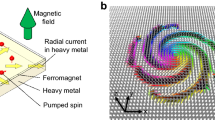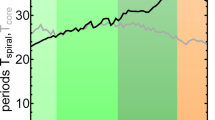Abstract
ROTATING spiral waves have been observed in various excitable media, including heart muscle1, retinae2, cultures of the slime mould Dyctiostelium discoideum3,4 and chemical oscillators such as the Belousov-Zhabotinsky (BZ) reaction5–7. Under certain conditions the spiral wave does not exhibit simple periodic rotation, but quasiperiodic8 (or 'compound'9) rotation, in which the spiral's origin (the tip) meanders10. Recent calculations11 have shown that highly meandering tip motion can impose superstructures on spiral waves. Here we reproduce these patterns experimentally, using the BZ reaction as the excitable medium. We induce high tip meander by applying pulses of electrical current locally at the tip12. Image processing of the patterns reveals a spiral wave of larger wavelength superimposed on the original wave, an effect that can be described in terms of a Doppler shift in the original spiral.
This is a preview of subscription content, access via your institution
Access options
Subscribe to this journal
Receive 51 print issues and online access
$199.00 per year
only $3.90 per issue
Buy this article
- Purchase on Springer Link
- Instant access to full article PDF
Prices may be subject to local taxes which are calculated during checkout
Similar content being viewed by others
References
Allesie, M. A., Bonke, F. I. M. & Schopman, T. Y. G. Circulation Res. 33, 54–62 (1973).
Goroleva, N. A. & Bures, J. J. Neurobiol. 14, 353–363 (1983).
Robertson, A. & Grutsch, A. F. Cell 24, 603–611 (1981).
Devreotes, P. N., Potel, M. J. & MacKay, S. A. Devl. Biol. 96, 405–415 (1983).
Muller, S. C., Plesser, T. & Hess, B. Physica D24, 71–86 (1987).
Agladze, K. I., Krinsky, V. I. & Pertsov, A. M. Nature 308, 834–835 (1984).
Zhabotinsky, A. M., Zaikin, A. N. in Oscillatory Processes in Biological and Chemical Systems, Vol. 2 (in Russian) (Nauka, Pushchino, 1971).
Zykov, V. S. Biofizika 31, 862–865 (1986); 32, 337–340 (1987).
Skinner, G. S. & Swinney, H. L. Physica D48, 1–16 (1991).
Winfree, A. T. Science 175, 634–636 (1972); 181, 937–939 (1973).
Perez-Muñuzuri, V. & Hanusse, P. J. nonlinear Sci. (in the press).
Perez-Muñuzuri, V., Aliev, R., Vasiev, B. & Krinsky, V. I. Physica D (submitted).
Agladze, K. I., Krinsky, V. I., Panfilov, A. V., Linde, H. & Kunhert, L. Physica D39, 38–42 (1989).
Meron, E. Physica D49, 98–106 (1991).
Hanusse, P., Perez-Muñuzuri, V. & Vidal, C. in Nonlinear Wave Processes in Excitable Media, NATO ASI Series B: Physics Vol. 244 (eds Holden, A. V., Markus, M. & Othmer, H. G.) 501–512 (Plenum, New York, 1991).
Author information
Authors and Affiliations
Rights and permissions
About this article
Cite this article
Perez-Muñuzuri, V., Aliev, R., Vasiev, B. et al. Super-spiral structures in an excitable medium. Nature 353, 740–742 (1991). https://doi.org/10.1038/353740a0
Received:
Accepted:
Issue Date:
DOI: https://doi.org/10.1038/353740a0
This article is cited by
-
Studies on Synthesis and Characterization of a Chemically Deposited Nanostructured Thin Film of Ternary Compound Silver Bismuth Sulfide (AgBi2S3) onto n-Type Wide Band Gap Semiconducting Titanium Dioxide (TiO2)
JOM (2023)
-
Structure of wave front and organization center in excitable media
Applied Mathematics and Mechanics (2004)
Comments
By submitting a comment you agree to abide by our Terms and Community Guidelines. If you find something abusive or that does not comply with our terms or guidelines please flag it as inappropriate.



